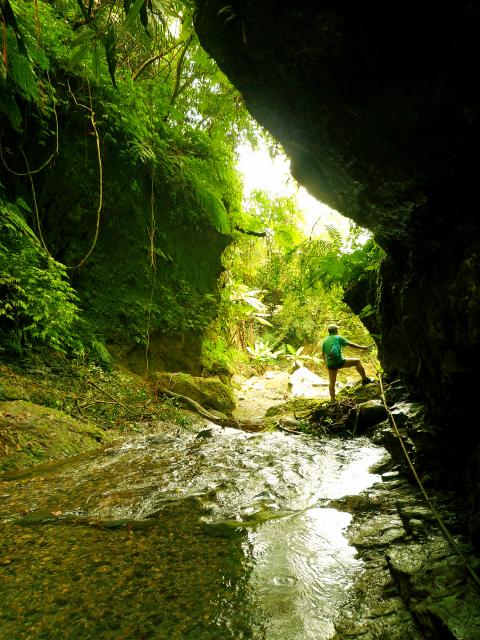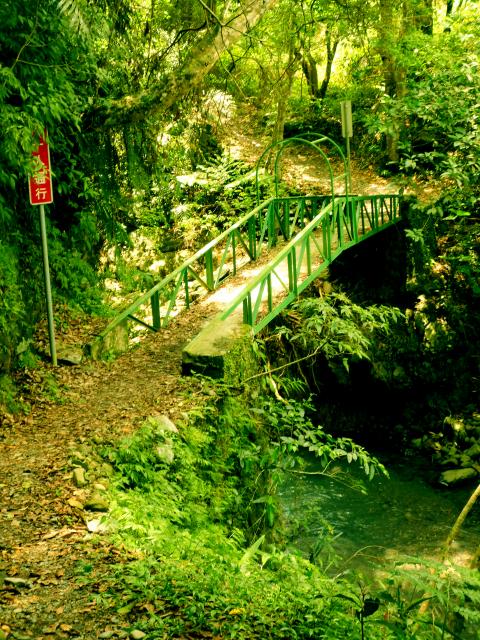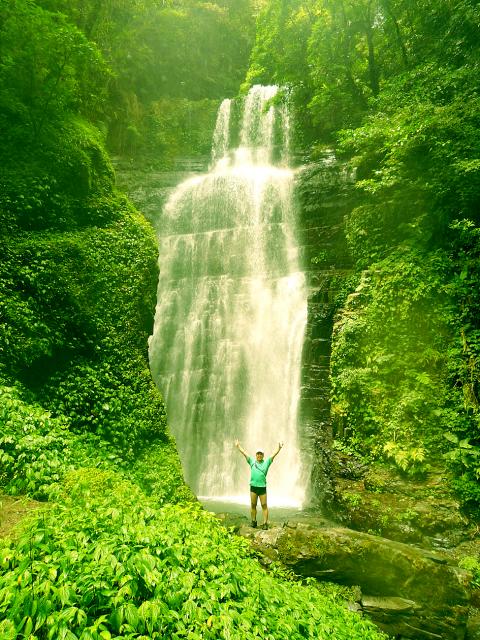Yilan County is so easy to reach these days that many favorite hiking spots in this beautiful corner of Taiwan are now feasible as day trips, yet I still have a nostalgia for the old days, when travelling there almost always meant taking a long bus ride along Highway No. 9.
Before the 12.9km Hsuehshan Tunnel (雪山隧道) opened in 2006, it took over two hours to travel from Taipei to the hot spring town of Jiaosi (礁溪). Sure, taking the train was quicker, and on a bright, sunny day the Pacific was a magnificent sight through the train window, but I’d happily forgo speed and relative comfort just to savor each time that marvelous few minutes when, after the bus had crossed the border between Taipei and Yilan, the road commenced the long descent to the Lanyang Plain (蘭陽平原) and the ocean, 600 meters below. Both came, abruptly and memorably, into view as the snaking road wound its way down the steep escarpment.
This part of Yilan County is one of the wettest corners of Taiwan, and the copious rainfall waters a stunning landscape of emerald-green, jungle-covered mountainsides dropping to a pancake-flat coastal plain of flooded paddy fields. Before developers moved in after the tunnel was built, the Lanyang Plain was a mass of bright green paddies during the wet summer months, dotted with solitary farmers houses and low-lying tombs, each of which to this day becomes a tiny island in a huge, shallow lake that forms after heavy rains. Today, the lush, forest-covered mountain slopes remain as pristine as they were, abruptly towering above the plain, and streaked with a series of impressive waterfalls which were the main reasons I used to make the long trip out from Taipei a couple of decades ago.

Photo: Richard Saunders
REMAINING WATERFALLS
The opening of Freeway No. 5 not only led to the extraordinarily rapid development of northern Yilan County, but also brought about one rather unusual casualty. The four Jinying Waterfalls (金盈瀑布) once included one of the highest in Yilan County. Today all four are dry, after the drilling of Hsuehshan Tunnel led to the draining of the stream that fed them. Five sets of waterfalls do, however, still plunge off the mountain escarpment (the northeast edge of the Snow Mountain Range) onto the Lanyang Plain between the tunnel and Jiaosi, and a couple of them have been popular weekend destinations for decades. The finest, however, was still a very well-kept secret just a decade ago, when I discovered it from the only post (in a popular Chinese-language hiking blog) to mention it in those days.
The morning we first visited the waterfall is a perfect example of the joys and sometimes amazing rewards of exploring “undiscovered” places. As we followed the directions I’d deciphered from the blog, neither I nor my friend were expecting much. In the one photo of it on the blog post, the waterfall looked pretty dull, half hidden behind a huge mass of rock and undergrowth that jutted out in front of it.

Photo: Richard Saunders
We almost didn’t find it. We walked straight past the indistinct trail that dropped down to the stream below the waterfall, and only discovered it by accident after we’d given up and were returning to the car. Expectations rose when the trail ended at a stream flowing through an attractive gorge, and our curiosity was truly piqued when, after wading upstream for about five minutes, the stream emerged from a tight, crack-like gorge. Ten minutes later we were standing right in front of Yuemeikeng Waterfall (月眉坑瀑布), staring in wonder at its beauty.
SECRET NO MORE
Nine years later, the once well-kept secret of Yuemeikeng Waterfall is little-known no more. Nowadays it’s hard to miss the once faint trail that leads down to the stream below the waterfall, and scraps of trail following the bank upstream allow hikers to keep their feet dry a bit longer, until the final, unavoidable 100-meter river trace up to the base of the waterfall. It’s almost certain that slightly tricky final approach to the waterfall keeps the numbers of visitors down to reasonable numbers: visit on a weekend and you may well have a local river tracing group and a few other hikers for company; on a weekday, you could be the only visitor.

Photo: Richard Saunders
To get there from the Wufengchi Scenic Area car park (a 10-minute shuttle bus ride from Jiaosi bus station), follow a path beside the stream to a large weir. Cross the stream immediately above it and follow a track gently uphill for about 10 minutes.
At a junction just after passing a small shrine, bear right, cross the stream by an iron footbridge, and follow the trail on the opposite bank. In about 10 minutes, take a clear trail on the left, and in about five minutes it joins the stream below the waterfall. Now simply wade upstream (or take the patches of trail beside the stream for the first five minutes) and the waterfall is a rough 15-minute walk/wade upstream.
The pool at the base of the waterfall is a perfect place to cool down on a hot summer day, but the waterfall is great for a visit year-round. If visiting in the cooler months, before heading back to the city, though, be sure to treat those legs to a leisurely soak in one of the wonderful hot springs at nearby Jiaosi. After all, it’s less than an hour back to Taipei.
Richard Saunders is a classical pianist and writer who has lived in Taiwan since 1993. He’s the founder of a local hiking group, Taipei Hikers, and is the author of six books about Taiwan, including Taiwan 101 and Taipei Escapes. Visit his Web site at www.taiwanoffthebeatentrack.com.

The canonical shot of an East Asian city is a night skyline studded with towering apartment and office buildings, bright with neon and plastic signage, a landscape of energy and modernity. Another classic image is the same city seen from above, in which identical apartment towers march across the city, spilling out over nearby geography, like stylized soldiers colonizing new territory in a board game. Densely populated dynamic conurbations of money, technological innovation and convenience, it is hard to see the cities of East Asia as what they truly are: necropolises. Why is this? The East Asian development model, with

June 16 to June 22 The following flyer appeared on the streets of Hsinchu on June 12, 1895: “Taipei has already fallen to the Japanese barbarians, who have brought great misery to our land and people. We heard that the Japanese occupiers will tax our gardens, our houses, our bodies, and even our chickens, dogs, cows and pigs. They wear their hair wild, carve their teeth, tattoo their foreheads, wear strange clothes and speak a strange language. How can we be ruled by such people?” Posted by civilian militia leader Wu Tang-hsing (吳湯興), it was a call to arms to retake

This is a deeply unsettling period in Taiwan. Uncertainties are everywhere while everyone waits for a small army of other shoes to drop on nearly every front. During challenging times, interesting political changes can happen, yet all three major political parties are beset with scandals, strife and self-inflicted wounds. As the ruling party, the Democratic Progressive Party (DPP) is held accountable for not only the challenges to the party, but also the nation. Taiwan is geopolitically and economically under threat. Domestically, the administration is under siege by the opposition-controlled legislature and growing discontent with what opponents characterize as arrogant, autocratic

Desperate dads meet in car parks to exchange packets; exhausted parents slip it into their kids’ drinks; families wait months for prescriptions buy it “off label.” But is it worth the risk? “The first time I gave him a gummy, I thought, ‘Oh my God, have I killed him?’ He just passed out in front of the TV. That never happens.” Jen remembers giving her son, David, six, melatonin to help him sleep. She got them from a friend, a pediatrician who gave them to her own child. “It was sort of hilarious. She had half a tub of gummies,